Sunday, September 02, 2012
The Zenith and the Zenit
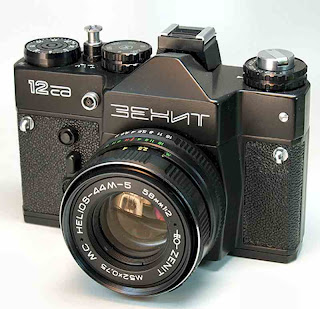 “Zenit” is
Russian for “zenith,” and is/was also the name of a Russian single lens reflex (SLR)
film camera, muchachos. Unk hopes his astrophotography has not quite reached its zenith, now that he’s just barely
achieved the twin milestones of stars that are consistently round and DSOs that
look more like what they are supposed to look like than custard pies, or,
worse, something that came out of the wrong end of his Aunt Lulu’s poodle dog.
“What?!” The subject for today is choosing a digital single lens reflex (DSLR),
something we’ve taken up before, but maybe not in detail. Now is the time.
“Zenit” is
Russian for “zenith,” and is/was also the name of a Russian single lens reflex (SLR)
film camera, muchachos. Unk hopes his astrophotography has not quite reached its zenith, now that he’s just barely
achieved the twin milestones of stars that are consistently round and DSOs that
look more like what they are supposed to look like than custard pies, or,
worse, something that came out of the wrong end of his Aunt Lulu’s poodle dog.
“What?!” The subject for today is choosing a digital single lens reflex (DSLR),
something we’ve taken up before, but maybe not in detail. Now is the time.
What’s one
of the most important steps in getting started in astrophotography? Buying the
right camera. That’s where the Zenit comes in. You must be careful picking a
camera. Almost any DSLR can perform at least semi-adequately for astro-imaging,
but considering all the effort, the blood, sweat, and tears you ARE gonna
expend learning the difficult art of astrophotography, you don’t want a camera
that is going to make your journey harder than it would otherwise be or
compromise your hard-won results. In other words, don’t pick a Zenit.
In 1995,
post My Best Girl, Unk was ready to take on (film,
natch) imaging again. Alas, there was a problem: he was SLR-less, at least for astronomy. His wonderful
Pentax K1000 was down for the count due to an unfortunate incident involving a
broken neck-strap and a concrete sidewalk. The Nikon FM2 that was even better?
It had gone with “the other party” in the course of a divorce.
That left my
Petri FT-II, which was not a bad camera and wouldn’t have been a bad
astro-camera, either, except for the fact that it had an odd non-standard lens
mount and I couldn’t get a T-ring (used to attach the camera to a telescope
prime focus adapter) for it. I borrowed my sister-in-law’s K1000 for a while during
Comet Hyakutake, but that wasn’t a long-term solution.
I needed a
camera, either a new K1000 or a similar mechanical, manual SLR; preferably one
that used Pentax’s then ubiquitous K-mount or screw mount lenses so I could
continue using the glass I had. A visit to the local camera store, Calagaz (still around in these latter digital
days, if in much reduced fashon) revealed two contenders (for penny-pinching
Unk): the genuine article, a K1000, or
a similar camera that seemed even better, a Ricoh KR-5.
The Ricoh
KR-5 Super II was a Consina-made 35mm manual SLR that could have been the
K1000’s twin. Except it was prettier, with an all-black body. More importantly,
it had one feature that definitely improved on the K1000, “mirror lockup.”
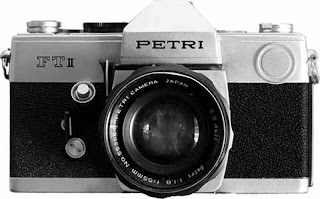 Normally,
the mirror that sends images to an SLR’s viewfinder pops up just
before the shutter opens to allow the picture to reach the film. That’s a no-no
for astrophotography. The mirror’s “slap” as it gets out of the way will
potentially vibrate the scope, making stars trail (modern DSLRs, most of ‘em,
still have moving mirrors, but mirror slap has been greatly reduced). The K1000
could be fooled into locking up its mirror before you released the shutter, but
that was hard to do and the KR-5’s system was better. It automatically locked
up the mirror 10-seconds before the shutter opened when you used its self-timer.
Normally,
the mirror that sends images to an SLR’s viewfinder pops up just
before the shutter opens to allow the picture to reach the film. That’s a no-no
for astrophotography. The mirror’s “slap” as it gets out of the way will
potentially vibrate the scope, making stars trail (modern DSLRs, most of ‘em,
still have moving mirrors, but mirror slap has been greatly reduced). The K1000
could be fooled into locking up its mirror before you released the shutter, but
that was hard to do and the KR-5’s system was better. It automatically locked
up the mirror 10-seconds before the shutter opened when you used its self-timer.
So I got the
KR-5? Yeah, but not immediately. I should have, but I messed up. The culprit
was Glen Patch’s old Shutterbug Magazine
(still around in different hands). It wasn’t the magazine per se, but its ads that led me astray.
The mid-late 1990s was the heyday of Russian Optics, with amateur astronomers
and, to a lesser extent, amateur photographers snapping up the cheap but
(somewhat) workable gear from the former USSR. Anyhoo, Unk began noticing ads
for Russian cameras. There were lots of ‘em, including medium format ones, but
Unk’s attention was caught by a “Zenit” manual 35 SLR.
It looked to
have what I needed: no shutter/iris automation, Pentax screw mount lens mount,
and, most of all, a cheap price. I took a couple of issues of the ‘Bug with me
when we visited Dorothy’s mom in Atlanta one spring and poured over the advertisements
and a couple of articles on the Russian cameras. I kept coming back to the
Zenit, which was an uber simple manual 35mm SLR…what could happen?
One
afternoon a week and a half or so after Unk had sent the U.S. importer of the
Russian cameras his credit card number, which was charged a rather miniscule
amount, a box was on the front porch of good old Chaos Manor South. Yay! I’d be
all ready for that cotton picking Comet Hale Bopp everybody was a-talking about.
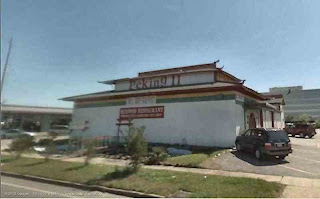 I tore into that
box, and therein found a very respectable if retro-looking black-clad SLR body
and a reasonably fast 55mm lens. Looked nice. Didn’t smell nice. Its leatherette covering had an odd, though not really bad, odor. Had Zenit finished their
camera with weasel leather? I also noted the plastic battery compartment cover
(for the light meter) was made of a plastic with the consistency of candle wax.
In the process of opening it, I scarred it badly.
I tore into that
box, and therein found a very respectable if retro-looking black-clad SLR body
and a reasonably fast 55mm lens. Looked nice. Didn’t smell nice. Its leatherette covering had an odd, though not really bad, odor. Had Zenit finished their
camera with weasel leather? I also noted the plastic battery compartment cover
(for the light meter) was made of a plastic with the consistency of candle wax.
In the process of opening it, I scarred it badly.
What was
important was how the camera worked. It felt nice in my hands and the
shutter/film advance seemed reasonably smooth. The next morning, Saturday morning,
I loaded up a roll of Tri-X, went down to the community theatre where my
brother was and is the Director, and fired off a few shots of various
photogenic things. Hurried right home and developed the negatives. Rut-roh.
The pictures
were impressively sharp, but… There was a dark band in every frame. At first I
thought something was amiss with the camera’s flash-sync, but, no, the artifact
was present in non-strobe shots, too. I emailed the dealer, who advised me to
send the camera back and they would fix the shutter. I boxed it back up and
dropped it off at UPS when D. and I were on our way to the Chinese restaurant
we favored in them days. Danged affair almost spoiled my appetite—but not
quite. Somehow I was still able to gobble up the many crab Rangoons I snatched off the buffet.
After a not
too long but still annoying wait, the Zenit was back. I loaded up another roll,
shot it, developed it, and saw the problem had not been fixed, though it had been improved slightly. Back in the
box my little Russkie went for a trip back to the importer and a refund for me.
When that refund appeared, I went down to Calagaz and bought a KR-5 like I
shoulda done in the first place.
The Richoh
served me well to the end of the film astrophotography days, so all’s well that
ends well, I reckon, and the trouble I had with the Zenit was instructive. The
moral of this little story? Don’t skimp
on the camera. That rarely works out. And you know what? Camera choice is
even more important in these DSLR days, which is Unk’s way of segueing into the
real subject of this morning’s blog.
If a DSLR is what you want. While a digital single lens
reflex is perfect for many astrophotographers of all skill levels, one is not
right for everybody. If you are pretty sure you want to chase the faintest of
the faint fuzzies, or long to do “real science” rather than just produce pretty
pictures, a cooled CCD camera is a better bet. An astronomical CCD is more
sensitive, less noisy, and easier to calibrate.
For the rest
of us, though? Those of us who are mostly
interested in nice pix of our favorite objects? DSLR all the way. And don’t kid
yourself; a current DSLR is not a bright object only deal. One will bring back
the Witch’s Head, the Horsehead, and other punishing targets. One’s just not
the choice if you fancy doing 20-hour-long LRGB exposures. Which sure ain’t
this old boy and probably ain’t most of you.
If you do decide
a DSLR will fit your Astrophotography agenda, the question then becomes “Which
DSLR?” There are many. In addition to all the old time SLR makers like Nikon,
Canon, and Pentax, plenty of electronics-oriented outfits have shifted from
camcorders (which are on the wane) to DSLRs. Sony has some good ones. So does
Samsung. Panasonic is in the game, too. So which?
I addressed
this question briefly quite a while back, and the answer has not changed: Canon. Not only are Canon cameras still
lowest in noise for long astrophotography exposures, Canon is the only company
that acknowledges that its cameras are used in astronomy, and the only outfit
that has produced cameras specifically designed for our art. Also, because of
their popularity with amateur astronomers, Canons are better supported with
astrophotography software and accessories than any other brand.
I like
Canons best both for astrophotography and general photography, but that doesn’t
mean Nikon and the others don’t make good DSLRs that can be used on the sky.
I’ve seen lovely images done with Nikons and Pentaxes and other brands as well.
If you are coming to a DSLR from a Nikon or Pentax SLR, for example, and have a
bunch of lenses you want to use with the new camera for both celestial and
terrestrial photography, I’d have a hard time nay-saying your choice of a Nikon
or Pentax (or whatever) DSLR. But Canons are still best for and easiest to use
on the deep sky.
OK, a Canon
then. But there are a lot of Canons… The choice is relatively simple. At the
top of the line are the pro grade cameras like the EOS1-D. It is a fine machine, but that fineness comes at a price, about
7,000 bucks for the body only. Luckily, most of us don’t need its capabilities
and features, which include a full frame (35mm sized) CMOS sensor. If
photography is your business, you sure could do worse, though, and this camera
will most assuredly produce outstanding images of the earth or sky.
Several
steps down is the 60d, which is much more
attractive for most of us. At about 900 dollars for the body only, it is likely
within the bounds of reasonableness for the majority of working
astrophotographers—especially considering that a meat-and-potatoes CCD cam will
set you back at least twice that amount.
Where do the
corners get cut on the 60d? In addition to eliminating some features of the top
cams that are mostly of interest to working pros—things like dual memory card
slots and advanced metering options—its CMOS sensor is smaller than 35mm. In
truth, that is not a problem for most of us. At 1300 – 1500mm of focal length, the
range most of us like to shoot at, most deep sky objects are well framed by Canon’s
APS-C format sensor. The chip yields nice big 5184 x 3456 pictures, and will
expose at speeds of up to ISO 12,800. Lots of folks will tell you the 60d is
almost perfect for the astrophotographer.
What is perfect? Some will say that’s the new
Canon 60da. Some years ago, Canon briefly produced a camera designed specifically
for astrophotography, the 20da. What was different about it was that its behind
the lens filter allowed more long wavelength light, including the red hydrogen
alpha light of nebulae, to reach the camera’s sensor. We were all pleased Canon
produced an astrophotography camera, but most of us didn’t expect such a
specialized model to stick around long, and it didn’t. I for one didn’t expect
such a camera from them again, either. Then, a few months back, Canon released
the 60da.
Not only
does the 60da incorporate a filter more biased to the red end of the spectrum
than the ones in their “normal” cameras, there’s even an AC power supply in the
box so your battery won’t poop out in the course of capturing NGC umptysquat.
Only slight downcheck? The price, about 1500 pieces of eight for the body only.
Still, that’s about what you’d pay for a similarly capable astronomical CCD
camera, and the 60da can be used for terrestrial astrophotography. While its
astronomy-friendly filter makes the pictures it produces in daylight slightly (and only slightly) warm looking,
it is trivially easy to fix that in post processing.
Fifteen
fracking hundred bucks too rich for your blood? How do you spell “relief”?
“R-E-B-E-L,” as in Canon’s Rebel DSLRs, and, specifically, the current top
Rebel, the T3i. For a price under 700
dollars for a body, you get most of the features of the more expensive 60d,
including the same excellent APS sensor. Despite its lower price, this Rebel plenty
of bells and whistles, including a “live view” display that allows real time
focusing on bright stars.
What does the
Rebel T3i give up to the 60d? A few features you probably won’t use for
terrestrial imaging and definitely won’t use on the sky and a lower top speed
of ISO 6400 rather than 12,800—neither of which are likely to be used by
astrophotographers, anyway. The Rebel’s build quality is somewhat less robust
than that of the 60d, but that should not be a problem. I know my own older
Rebel, an Xti, has taken a lickin’ but kept on tickin’.
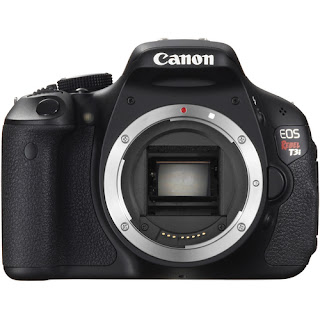 How about
buying used? That’s a possibility if you can find a really good condition
camera for a really good price. I usually advise against it, however. The 60d
and T3i are reasonably priced new to begin with, and it is probably wise to buy
new in this range if possible. DSLRs are electronic devices and can be more
troubled by abuse than the old mechanical SLRs were. Buying used is an option
to consider when buying a high-priced professional level DSLR like the Canon 1D
and 5D, but, be forewarned, most pros put an awful lot of miles on their
cameras before they sell ‘em.
How about
buying used? That’s a possibility if you can find a really good condition
camera for a really good price. I usually advise against it, however. The 60d
and T3i are reasonably priced new to begin with, and it is probably wise to buy
new in this range if possible. DSLRs are electronic devices and can be more
troubled by abuse than the old mechanical SLRs were. Buying used is an option
to consider when buying a high-priced professional level DSLR like the Canon 1D
and 5D, but, be forewarned, most pros put an awful lot of miles on their
cameras before they sell ‘em.
Of course an
off-the-shelf Rebel of any sort will have the standard internal filter and will
be less sensitive to the light of nebulae than the 60da. That’s not necessarily
fatal. Clusters and galaxies are mostly unhindered by the IR filter of a
standard camera, and an off-the-shelf camera can still do a good job on nebulae
from M42 to the Horsehead. Exposures will need to be longer, and you will have
to tweak the images for a “normal” (whatever that is) color balance, but you
can bring back the shots.
If you are
obsessed by objects like the California Nebula and think you really need an
H-alpha enabled camera and don’t want to spend for the 60da, there is another
way. Several reputable outfits including HapGriffin’s company will modify a standard camera for you, removing the IR
filter and replacing it with either a clear filter, or a filter designed to
enhance astronomical subjects. Good idea? Maybe. If you can find a used camera
body for a reasonable price, you can undercut the price the 60da considerably.
Some of
these outfits, including Hutech, sell new
cameras with the modification already done. Alas, the price of a new Canon 60d
with the mod is similar to that of the 60da. The advantage is that you can
purchase a modified T3i and save several hundred off the price of the 60da.
Caveats? If
you worry about such things, modifying a DSLR will likely void its warranty
whether you do it or a professional does it. Another thing to consider is that
the modified cameras are usually much more sensitive to red light than either
an unmodified camera or the 60da.
That may be a good thing if you are going after the faintest gas clouds, but it
compromises the camera for daylight use; an IR filter and/or custom white
balances are required for daylight use. From what I have seen, modified cameras
also tend to be noisier than the 60da.
The 64
dollar question, though, is, modified or unmodified, how does a DSLR compare to
a real CCD camera? A little more
than four years ago Unk decided to find out. You can read the story here, but in a nutshell I bought my Canon Rebel Xti
mostly to take good quality terrestrial images for my books and magazine
articles. You can bet your bippy I was also gonna try the camera with a
telescope, of course. I headed down to the Chiefland Astronomy Village with it
and my trusty C8 and Atlas.
What did I
think? Though I started easy and bright with M42, I could still tell the Canon
would be more than sensitive enough to get good pictures of most objects,
especially since I had no interest in using it to grab PGCs and Hicksons and
stuff like that—I have a genu-wine SBIG CCD cam for those suckas. Not that I’ve
used that fine camera much since my little Rebel came to stay at Chaos Manor
South.
The reasons for
that are that I am lazy and I live where astrophotography is a sometimes thing
given the weather. The lazy bidness comes into play due to my desire for color.
I still like black and white images, but, like most of y’all, I prefer color.
Doing color with my CCD means three or four separate exposures through filters.
Yes, you can get “one shot color” cooled CCD cameras, but a DSLR is still
easier to use. While you can operate a Canon DSLR with a computer (using Nebulosity or other
programs), you can also image with one using nothing more than a remote shutter
release.
As for our Possum
Swamp weather? If I get one imaging-worthy night every few months, I am doing danged
well. I can’t justify a state of the art CCD to the tune of 3 – 5 grand if I
rarely get to use it. Not only is a DSLR cheaper, one’s ability to take amazing
terrestrial photos makes the 700 – 1500 most of us will spend on one a more justifiable
expense.
“But Uncle
Rod, but Uncle Rod… It ain’t just higher sensitivity that makes CCDs better,
there’s noise, thermal noise. Real CCDs, most of ‘em, are cooled. Don’t that
mean they beat the tar out of uncooled DSLRs?” Not in my experience, Skeezix.
I’ve done plenty of M13 shots on nights where the temps never dropped below
80F. Dark frames, which some DSLRs will automatically take and subtract for you,
have always done the job in eliminating thermal noise. And there are other
alternatives. Orion has just released a DSLR cooler.
I don’t know pea-turkey about it, but it looks interesting.
To lay my
cards on the table, I have gone DSLR and have not looked back. Which is also, I
reckon, due to nostalgia as well as convenience and practicality. With my DSLR
on the scope feel like I’m PHOTOGRAPHING the night sky again. Camera on prime
focus adapter and away I go. No computers (unless I want to use one), just a
friendly Canon that’s really a lot like my old film SLRs. I do miss the smell
of darkroom chemicals, but otherwise the experience is much the same.
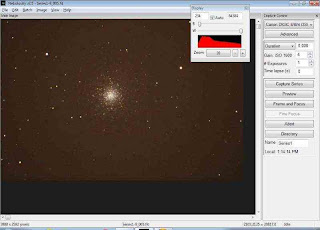 I was a
little embarrassed at first to be on the observing field without a real CCD, but got over it after an
astrophotographer whose work I admire told me he thought there was no reason to
use anything but a DSLR these days if
you don’t want to do SCIENCE, muchachos. If anybody needs further convincing,
all you gotta do is look to the work of DSLR masters like Jerry Lodriguss. Just try to tell me his images ain’t
up there with those done with CCDs. I won’t naysay those of y’all who are still
in the SBIG/Apogee/Starlight Xpress/ATIK camp. I admire your work and
persistence. But me? I’ll just keep taking my friendly little deep sky snapshots
with my friendly little Canon Rebel.
I was a
little embarrassed at first to be on the observing field without a real CCD, but got over it after an
astrophotographer whose work I admire told me he thought there was no reason to
use anything but a DSLR these days if
you don’t want to do SCIENCE, muchachos. If anybody needs further convincing,
all you gotta do is look to the work of DSLR masters like Jerry Lodriguss. Just try to tell me his images ain’t
up there with those done with CCDs. I won’t naysay those of y’all who are still
in the SBIG/Apogee/Starlight Xpress/ATIK camp. I admire your work and
persistence. But me? I’ll just keep taking my friendly little deep sky snapshots
with my friendly little Canon Rebel.
Next Time: SkyTools for Dummies…
Comments:
<< Home
Nice article Rod. Reminds me of my very first SLR camera as a teenager - the godd 'ole Russian Zenit B. Took a lot of pics with that camera. (Wish I still had it for old time sakes ;-) [Yes, spoken like a true pack rat...]
Peace & blessings,
The Astro Monk (aka - Donn)
http://TheAstroMonk.blogspot.com/
Post a Comment
Peace & blessings,
The Astro Monk (aka - Donn)
http://TheAstroMonk.blogspot.com/
<< Home





